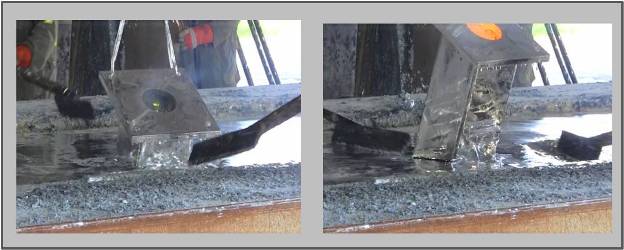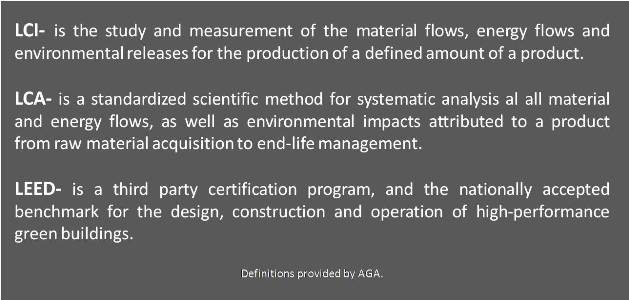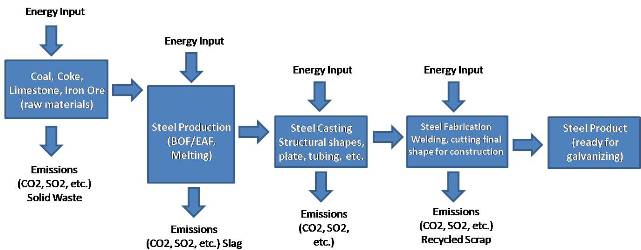Over the past couple of decades, environmental awareness has been on the rise as more people are paying attention to how they can help preserve natural resources and lighten their carbon footprint. In the energy sector, this has been a controversial topic for many years. Refineries have been shut down, as well as nuclear plants and other industrial facilities due to greenhouse emissions and other environmental impacts.
More recently, concerns have been raised about whether or not hot-dip galvanizing is sustainable. Just to refresh your memory, hot-dip galvanizing is the process of coating fabricated steel by immersing it in to a bath of molten zinc that metallurgically bonds the zinc to the steel. This practice has been around for over 150 years, and provides maintenance-free corrosion protection for decades. Also, galvanized steel used in public construction is an efficient use of tax dollars, due to the no maintenance for decades.
There are three fundamental steps in hot-dip galvanizing: surface preparation, galvanizing and inspection. During step one, surface preparation, the steel goes through three cleaning steps; degreasing, pickling and fluxing. It is pertinent that the steel surface is clean because zinc will not react. During the second step, galvanizing, the steel is dipped into a molten bath at 840 F, that is made up of 99 percent zinc. In the final step, the steel can either be visually inspected to find areas that did not react or a magnetic thickness gauge can be used to verify if coating thickness meets requirements.

Sustainability
Sustainable Development (SD), according to the American Galvanizers Association (AGA), is the social, economic and environmental commitment to growth and development that meets the needs of the present without compromising the ability of future generations to meet their needs. The two most well-known and accepted ways for measuring sustainability are the combination of life-cycle inventory (LCI) and life-cycle assessment (LCA), and the US Green Building Council’s Leadership in Energy and Environmental Design (LEED).

The two primary elements in hot-dip galvanized steel are zinc and steel, which both have high recycling rates. The recycled content is determined by weight and then the recycled fraction is multiplied by the cost of the assembly to determine recycle content value. Hot-dip galvanized steel becomes one product when the zinc metallurgically reacts with the iron, becoming more than 70 percent combined recycled content, which definitely meets the requirements of Credits 4.1 and 4.2 of the Materials & Resources Credit 4: Recycled Content category.
 (a)International Zinc Association (IZA), Zinc Recycling, 2004. (b)Steel Recycling Institte, Steel Takes LEED with Recycled Content, March 2009
(a)International Zinc Association (IZA), Zinc Recycling, 2004. (b)Steel Recycling Institte, Steel Takes LEED with Recycled Content, March 2009
To further explain, let’s break down what zinc and steel actually are. Zinc is the 27th most abundant element in the Earth’s crust and exists naturally in water, air and soil. Annually, about 30 percent of the world’s zinc supply comes from recycled sources, and about 80 percent that can be recycled is reclaimed. Zinc is also essential for humans, and aids in kidney function, breathing, digestion, diabetes control and much more. Zinc can also be found in a number of products such as cosmetics, tires and in treatments like sunscreen, diaper rash, burns and more. But also to make note, an abundant amount of zinc to humans can be very harmful.
Steel is the most recycled material in the world, with 70 percent made from recycled material. It has also been vital in construction since the industrial revolution took place back in the early 1800s. But, if steel is left unprotected, it will fall victim to corrosion.
Waste Created?
LCI also examines how much solid waste is created throughout melting the material, casting into pieces and then fabricating the steel. The figure below, provided by AGA, shows just how little of solid waste is created.

Hot-dip galvanizing isn’t something new. It’s been around for centuries, and has been proven to protect steel from corrosion, while having minimal environmental, economic or social impacts.
